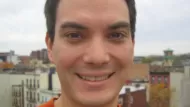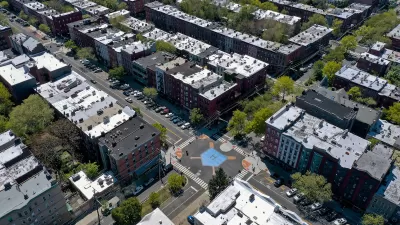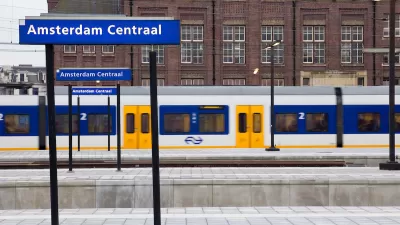"One of the reasons Amsterdam feels so cozy," says my workmate as we walk along busy Vijzelstraat on a sunny Saturday afternoon, "…is that everything is moving so slow." For a packed city street with throngs of people, bicycles of all configurations nipping along the curbline, and traffic mixing with trams, the word "slow" may not be how others would describe Amsterdam, but in traffic engineering parlance, that is exactly what is going on.

In fact, the average speed in downtown Amsterdam is 15kph (10mph) whether in a tram, on a bike, or driving your own car. "That's too slow!", so may say the busy driver rushing through the city, but if quality of life for residents of said city is part of the points, 15kph is what gets you a "cozy" score. At this speed, a car can pass just beside you without interrupting your conversation (but still splashing your pantleg, so beware!). Perhaps more important, vehicles operated so slow must be woefully mishandled to actually hit you, and even in the event of contact it's difficult to do much damage (although even Amsterdam is unfortunately not immune from traffic injuries and fatalities). When safety, quiet, and comfort are part of a city's priorities, perhaps 15kph "slow" is not so bad.
Slow is undoubtedly an explanation why so many parts of this energetic city feel both bustling and bucolic at the same time. Turn off a larger street like Vijzelstraat onto a canal side street and busy turns to calm at the corner. All the while bikes and cars and trams – and all kinds of mutant modes inbetween - are moving alongside pedestrians. There's activity but it's more like the charm of a village main street than a major European city. Admittedly, this kind of mix wouldn't work everywhere – after all, you need a cultural psyche that recognizes value in human life to succeed – but there is a lot to learn from slow streets.
Most of us know that slow speeds can dramatically reduce the likelihood of fatality when a pedestrian is hit by a driver, but slow is helpful for other reasons. For example, slow permits vehicle access (as opposed to full closures) but sets clear limitations so that only those who really need to drive vehicles in a certain area will want to do so. Other drivers willl simply prefer other easier ways to get to where they are going. It's obvious if said, but when planning roadways we sometimes forget that designs for high speed and fast throughput invite more traffic volume; Amsterdam has seen a reduction in automobile traffic and a balancing of modes in the city center not because of any war on cars, but because no one mode gets a major advantage over any other. In fact, autos and bicycles take approximately 30% each of the downtown trip-share, while trams and other modes make up the balance. Automobile volumes downtown are not just light on paper, they feel light when walking around the city. So slow discourages all but necessary vehicular traffic from navigating city streets, which leaves more room for others to get around. Before the trip even happens, slow better balances the comparison for individual trip-takers considering their modal choices.
Slow is not-surprisingly more about perception than it is reality. In Hoboken, New Jersey (a Dutch connection at least in name) when introducing there the "Twenty is Plenty" campaign, we were challenged by higher-speed zealots who argued they'd "Never get through the city at that speed!" Downshifting the speed limit from 25mph to 20mph required more than years of legislative logic-stepping, it also required local logic-speak to explain that a drive across town at 20mph only requires 70 seconds more than a drive at 25mph. When 70 seconds inconvenience is held up against the safety of children, elderly, disabled, and drivers' neighbors and family (who are all pedestrians at some point in Hoboken), it's hard to argue against the change. Admittedly Hoboken is a small city, but with respect to local neighborhoods, Hoboken's streets are no different than those in any other city.
Slow also has more arcane benefits. Traffic engineers (albeit some only when up against the wall) can demonstrate how slower speeds translate to better processing of traffic volumes through any given point in a given time. This is counter-intuitive at first; the explanation is that slower speeds allow vehicles to travel closer together (shorter gaps between cars), which means that more cars can get through an area within a set period of time. You can try this at home; invite one-hundred of your closest friends to drive along a roadway at the posted speed limit and count how long it takes them to all get through a given segment. Then, try it again at half that speed. During peak periods of traffic when a city wants to get as many cars through - or out of - an area as possible, managing traffic at slow speeds may be surprisingly but nonetheless still effectively more desirable than at highway speeds.
Lastly, I submit a somewhat subjective point, but perhaps meaningful nonetheless. Slow maintains neighborly interaction regardless of whether you happen to be on foot, bike, or in a car at the moment. I am sure there are some with subdivision supervision who pride themselves at being able to recognize their neighbors' faces - or even worse simply by their car – on 200 foot radius curves and speeds upwards of 45mph, but the slow alternative makes it easy to see, smile, even wave at a neighbor as they pass by with enough time to avoid that awkward feeling one gets after quizzically waving or gaping on reaction.
Drivers may be understandably nonplussed with the idea of lower speeds in cities, but doing so is not just an equalizer between modes, it helps make a city friendlier to all its inhabitants and visitors. Slow speed is not simply about adjusting speed limits (although this has certainly worked in many places), it is about a street plan that properly distributes limited space across various modes so each gets its fair share, with fair share being the objective modal split that makes most sense for each individual city. Amsterdam works quite well with its modes split into even thirds; that is only possible because the city works so hard to carefully divvy up the streets. One can only wonder how such balanced street planning if used in other cities could bring "cozy" closer to home.


































